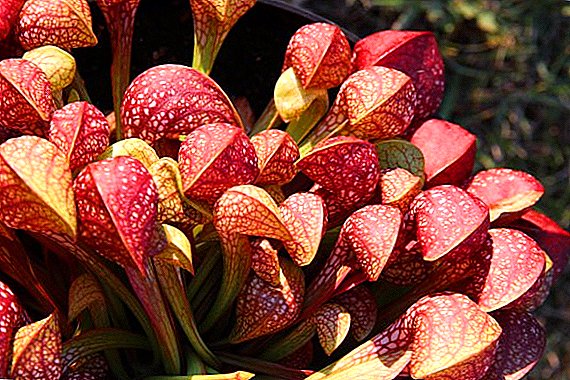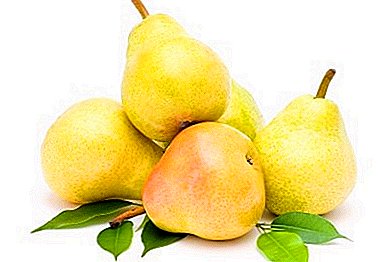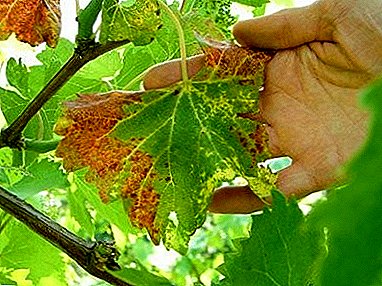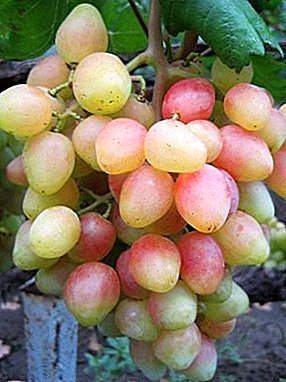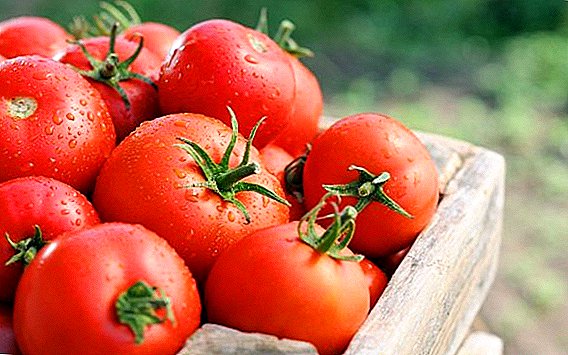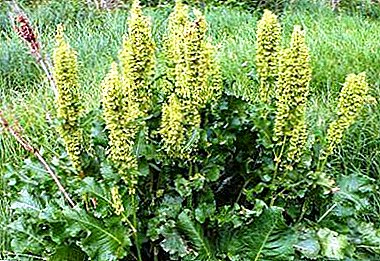 Varieties of primrose species affect both the number of species and the variety of flower shape. This genus includes 550 species, and the work of scientists on the breeding of new varieties does not stop. In order to restore order in this abundance, it is necessary to divide the primrose varieties into sections. Each of them combines varieties similar in certain features.
Varieties of primrose species affect both the number of species and the variety of flower shape. This genus includes 550 species, and the work of scientists on the breeding of new varieties does not stop. In order to restore order in this abundance, it is necessary to divide the primrose varieties into sections. Each of them combines varieties similar in certain features.
Did you know? Since the primrose is called primrose with flowers, gathered in an inflorescence in the form of a bunch of keys, many Slavic peoples identify it with keys that open the way to the green kingdom of summer in the spring. And in Germany they claim that they are the keys of marriage.
Mealy Primrose Section
This selection includes approximately 90 species of plants, the distinctive feature of which is a yellow or white mealy coating on the leaves, especially from the bottom. Flowers are lilac, purple, yellow or white. Flower petals are usually shorter than calyx petals. Plants are biennials. Basically, many species are home to Asia. The plant grows well in drained soils that are rich in humus and have high humidity. Plants need shelter for the winter.  The selection includes the following main types:
The selection includes the following main types:
- The Norwegian Primula (R. finmarchica) is a perennial plant up to 20 cm high. The flowers are purple or pink in color, placed on long peduncles of 3-5 pieces in umbrella inflorescences. Leaves collected in the rosette. It grows from Eastern Europe to the tundra zone. The flowering period is June-July.
- Mealy Primula (R. farinosa) is a primrose perennial plant of the genus. It grows 15-20 cm in height. The leaves are 8 cm long, finely toothed at the edges, have a white mealy coating. Flowers in diameter of 1 cm form an umbrella. Their color can be lilac or white with a yellow center. The flowering period is May-June. Used in folk medicine for dermatitis and to enhance hair growth.
- Daryal primula (R. darialica);
- Haller's Primula (R. halleri);
- Primula Hungen (R. chungensis);
- Scottish primrose (R. scotica);
- Primula leafy (R. frondosa);
- Primula snow (R. nivalis);
- Siberian primula (R. sibirica);
- The primrose is cold (R. algida) and others.
Section OREOPHLOMIS
The section includes perennial species of primroses with small and medium flower size. The flowering period occurs in early spring. Their distinctive feature is smooth leaves with small teeth on the edge and pink flowers with a yellow middle.  The representative of this section is
The representative of this section is
- Primula pink (R. Rosea) - a plant with small flowers of pink flowering peduncles 12-15 cm tall. Flowering occurs in May. The leaves begin to grow intensively only after flowering and become light green in color. It prefers swampy soil, breeds by dividing the bush in the first half of summer or by seeds.
Auricular Section
The section combines 21 species of primroses, whose homeland is considered to be Europe. Plants are stunted with pink, lilac, purple flowers with white or yellow center. The leaves are succulent, and the stems and flowers are covered with a mealy bloom. Plants propagate with seeds that are sown in the fall, and germinate in the spring or segments of rhizomes. After sowing, it is recommended to sprinkle the seeds with a thin layer of sand.  Consider the main representatives of this section:
Consider the main representatives of this section:
- Ear primula or auricular (R. auriculaL.) - a plant unpretentious and winter-hardy. Prefers a garden moist, fertile soil rich in calcium, and a sunny or semi-shaded place. The most widespread plant acquired in England. The leaves are evergreen, dense, with cloves along the edge. The natural appearance has yellow flowers, and hybrids have a varied color.
- The pubescent primrose (R. x pubescensJacq.) - is a hybrid of auricular primrose. A large number of primroses of various colors were derived from this species. This species is divided into Belgian primroses (without powdery plaque, one- or two-colored with a yellow eye), English (with a mealy patina, flowers with a white eye and stripes emanating from the center), terry.
- Delecluse primula (R. clusiana);
- Primula stiff-haired (Рrimula hirsutaAll, P. rubraF. Gmel.);
- Primula Carnioli (R. carniolica);
- The primrose is small (P.minima);
- Primula fringed (P. Marginata).
Cortus Primrose Section
Section combines 24 types of primroses. Plant without powdery plaque. The leaves have petioles, and the flowers are funnel-shaped. These species are easy to grow in fertile soils both in the sun and in partial shade. Propagated by seeds, and Siebold primula - by dividing rhizomes.  The main representatives of this section include:
The main representatives of this section include:
- Primula Cortus (R. cortusoides) - is the most common representative of this section and is found from Europe to Siberia. It has a short horizontal rhizome. The leaves are oval-shaped with a serrated edge, placed on long petioles. On thin pubescent peduncles (10-40 cm) umbellate inflorescences of red-violet color are placed. The flowers have a deep recess in the middle and do not exceed 2 cm in diameter. The flowering period is May-June for 35-40 days.
- Rock primula (R. saxatilis) - perennial plant up to 30 cm high. Flowers of lilac color. The leaves have dissected edges and a wrinkled structure. The flowering period is April-June. Refers to frost resistant. He loves loamy, loose, moist ground and sunny place. Often used for decorating stony hills. Ingestion may cause poisoning.
- The primrose is multiple nerve (P. polyneura)
- Primula rejected (R. patens Turcz);
- Zibold's primula (R. sieboldii).
Tooth Primrose Section
This section combines the species of primroses, the flowers of which are collected in a large capitate inflorescence.  The main representatives of this section include:
The main representatives of this section include:
- Primula fine-toothed (R. denticulata Smith) - China is considered the birthplace of the plant. The plant is covered with a mealy yellow bloom. Leaf sockets are large, light green in color, during flowering have a length of up to 20 cm, and after flowering - up to 40 cm. The peduncles reach a length of 20-25 cm during flowering. The flowers are white, purple or lilac. The flowering period is April for 30-40 days. Seed multiplication prevails. Refers to winter hardiness. Loves both a sunny place and partial shade.
- Primula capitate (R. Capitata).
Julia section
Only one species and its hybrids are included in the section:
- Primula Yulia (R. juliaeKusn.) - plant height 10 cm. The rhizome is short, tuft-like, brownish in color. The leaves are oval-shaped, light green with teeth on the edge, placed on long petioles. Peduncles thin - up to 15 cm tall. Flowers up to 3 cm in diameter, arranged one by one and have a purple-lilac color. Flower tube has a length of up to 2 cm. Flowering period - April-May. Refers to unpretentious and shade-tolerant species of primroses.
- Prigula Pruhonitskaya (R. x pruhonicianahort.) - Julia hybrids, combining many varieties of different colors.

Muscarios Section
The section combines 17 species, which differ in the form of inflorescences in the form of pointed cylinders. Asia is considered the birthplace of these species. Plants belong to the biennials, so for annual flowering it is necessary to plant new plants annually. Care involves abundant watering during the growing season and shelter for the winter.
- Primula Viala (R. vialii) - refers to the perennial plants. Its height reaches 50 cm. Inflorescences are spiciform, lilac-pink color. The leaves are large, wrinkled. The flowering period is June-July for 30-40 days. It prefers fertile, friable, well-moistened soils and a sunny or semi-impermeable place. Winter needs shelter.
- The muskarevid primrose (R. muscarioides).

Primrose section
The section combines easy-to-grow types of primroses without powdery spraying. Reproduced these types of seeds and the separation of the bushes.
The section includes the following types:
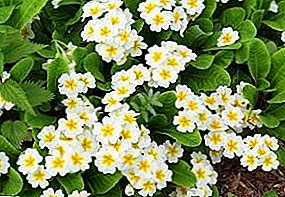 Primula charming (R. amoena) - refers to the perennial plants. It grows in the Caucasus and Turkey. Reaches a height of up to 20 cm. The leaves are oval-shaped, up to 7 cm, with short petioles and fine teeth on the edge. Top - bare, bottom - velvety. The length of the peduncle reaches 18 cm. The flowers of purple are gathered in one-sided umbellate inflorescence. On one peduncle up to 10 flowers with a diameter of 2-2.5 cm.
Primula charming (R. amoena) - refers to the perennial plants. It grows in the Caucasus and Turkey. Reaches a height of up to 20 cm. The leaves are oval-shaped, up to 7 cm, with short petioles and fine teeth on the edge. Top - bare, bottom - velvety. The length of the peduncle reaches 18 cm. The flowers of purple are gathered in one-sided umbellate inflorescence. On one peduncle up to 10 flowers with a diameter of 2-2.5 cm.- The stemless primula (R. vulgaris) grows in Western and Central Europe, in the Middle East, in Small and Central Asia, in northern Africa. The leaves of the plant are lanceolate, some of them are preserved in winter. Peduncles about 20 cm long, on which are single flowers of light yellow or white with a purple throat color up to 4 cm in diameter. It blooms in April for 25 days. May re-bloom in September.
- Primula high (R. elatior);
- Abkhazian Primula (R. abchasica);
- Primula Voronova (R. woronowii);
- Primula Pallas (R. pallasii);
- Primula Komarova (R. komarovii) and others.
Candelabra Primrose Section
The section includes 30 species of primroses. On high peduncles in the summer appear inflorescences, which are arranged in rings, so the plant was called the candelabra primrose.. Care involves shelter for the winter.  This section includes the following types:
This section includes the following types:
- Japanese Primula (R. japonica) - Japan and the Kuril Islands are considered to be the birthplace of the plant. On a high peduncle 40-50 cm long flowers of crimson or white are placed in tiers. Such tiers can be up to 4-5 pieces. The plant blooms in June and July. It prefers a fertile moist soil with a place in the penumbra and shade. Flowers lose their brightness in the sun. Winter needs shelter. Transplanting plants is best done immediately after flowering - in August.
- Powdered primula (R. pulverulenta) - marshy areas of China are considered the birthplace of the plant. The peculiarity of this species is the whitish bloom on the peduncles and leaves of the plant. One of the most decorative candelabra primroses.
- Bissa primula (R. beesiana);
- Kokburna primula (P. coekburniana);
- Primula Bulley (R. bulleyana), and others.
Important! The primula contains salts of manganese. The leaves of the plant are rich in ascorbic acid and carotene, so they are eaten in early spring. The rhizomes contain saponins, essential oils, glycosides. They are used as a medicinal plant for rheumatism, respiratory diseases, as a diuretic. Broths of leaves are used for colds, insomnia, headaches.
Primrose species classification
German growers proposed classification types of primroses, based on the shape and location of primrose inflorescences.
Pillow
This group includes species of primroses with single individual peduncles, which slightly rise above the leaves of the plant.
- Primula Voronova (R. Woronovvii);
- Prugonitskaya primula (R. x pruhoniciana);
- Primula ordinary or stemless (R. vulgaris = P. Acaulis);
- Primula Julia (R. Juliae);
- The primrose is small (R. Minima).

Did you know? Great lover primrose was Empress Catherine the Great. She really liked the collection of auriculars of one grandee, and he gladly presented her to the empress. The next day, the entire collection was transported to the Winter Garden in St. Petersburg.
Umbrella-like
There are combined species of primroses, the flowers of which are collected in a one-sided umbrella. The height of the peduncle, which rises above the rosette of leaves, is up to 20 cm.
- Spring primula (R. Veris);
- Siebold Primula or rejected (R. sieboldii = R. Patens);
- Primula high (R. Elatior);
- A primrose is polyanthic or a primrose multi-flowered (R. Poliantha);
- Primula pink (R. Rosea);
- Ear primula or auricular (R. Auricula).
Capitolate or globose
This group combines the species of primroses, whose flowers are collected in dense capitate inflorescences. Peduncle is dense, and during flowering its length reaches up to 20 cm, and in the period of fruiting up to 45 cm. 
- Primula capitate (R. Capitata);
- Primula fine-toothed (R. Denticulata).
Tiered
Primroses of this group have spherical inflorescences consisting of several tiers. Peduncles strong and similar to the shape of a candelabra.
 Bissa Primula (R. Beesiana);
Bissa Primula (R. Beesiana);- Bullei Primula (R. Bulleyana);
- Powdered primula (R. Pulverulenta);
- Japanese Primula (R. Japonica).
Bell-shaped
This group includes primroses with dangling flowers, placed above the rosette of leaves on peduncles of various heights.
The most famous of them are:
- Primula Florinda (P. florindae);
- Sikkim Primrose (P. Sikldmensis).
 Primula Cortus (R. Cortusoides);
Primula Cortus (R. Cortusoides);- Primula Komarova (R. Komarowii);
- Siberian primula (R. Sibirica);
- Mealy Primula (R. farinosa);
- Primula Ruprecht (P. ruprechtii);
- Primula Orchid or Vialla (R. Vialii);
- Large primula (P. Macrocalyx);
- Norwegian Primula (P. Finmarchica);
- Primula Pallas (R. Pallasii);
- Primula fringed (R. margininata);
- Primula snow (R. Nivalis);
- Chionanta primula (P.chionantha);
- Primula cold (R. Algida);
- Scottish primrose (R. Scotica).
Important! Scientists claim that primroses predict volcanic eruptions. It is noticed that on the island of Java Royal primrose blooms only on the eve of the eruption. It is believed that the cause of this ability is ultrasonic vibrations that accelerate the movement of fluid in the plant, which leads to unexpected flowering.
Primroses combine many positive factors: they are not demanding when grown, have early and long flowering, are resistant to cold, and their varieties satisfy even the most sophisticated grower.


 Primula charming (R. amoena) - refers to the perennial plants. It grows in the Caucasus and Turkey. Reaches a height of up to 20 cm. The leaves are oval-shaped, up to 7 cm, with short petioles and fine teeth on the edge. Top - bare, bottom - velvety. The length of the peduncle reaches 18 cm. The flowers of purple are gathered in one-sided umbellate inflorescence. On one peduncle up to 10 flowers with a diameter of 2-2.5 cm.
Primula charming (R. amoena) - refers to the perennial plants. It grows in the Caucasus and Turkey. Reaches a height of up to 20 cm. The leaves are oval-shaped, up to 7 cm, with short petioles and fine teeth on the edge. Top - bare, bottom - velvety. The length of the peduncle reaches 18 cm. The flowers of purple are gathered in one-sided umbellate inflorescence. On one peduncle up to 10 flowers with a diameter of 2-2.5 cm. Bissa Primula (R. Beesiana);
Bissa Primula (R. Beesiana); Primula Cortus (R. Cortusoides);
Primula Cortus (R. Cortusoides);